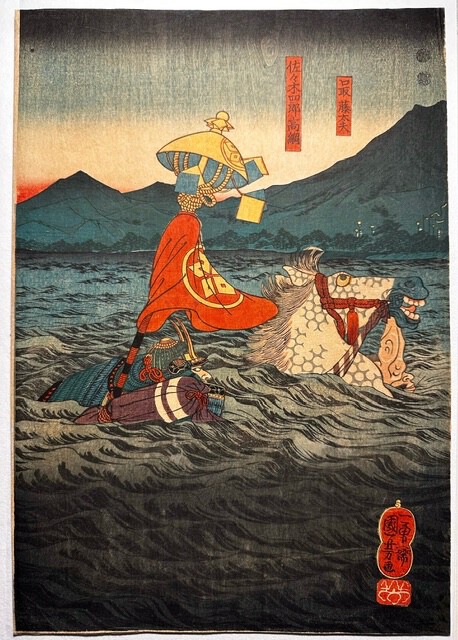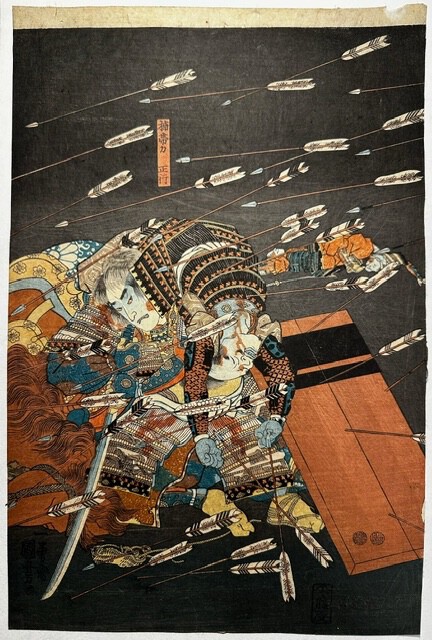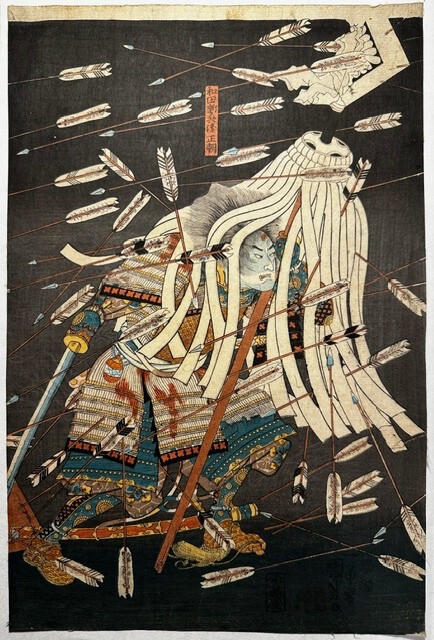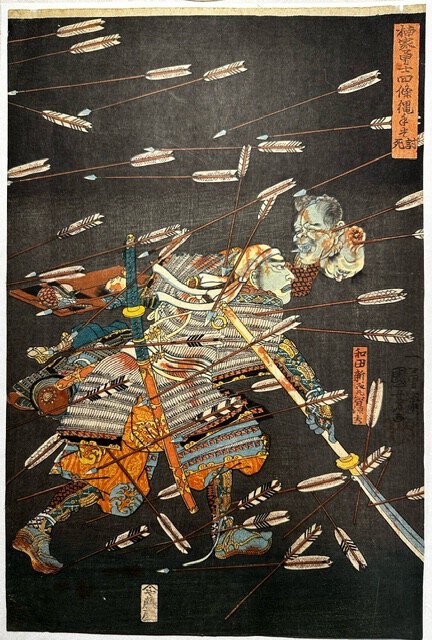
Richard Thomas
Members-
Posts
34 -
Joined
-
Last visited
-
Days Won
1
Everything posted by Richard Thomas
-
Jeff, you’re right, Robinson Kuniyoshi the warrior prints is not as visually rich as other books, there are some colour plates but mostly black and white. Though It is pretty much the standard reference for series identification in the west, but a little dated now. Kuniyoshi - the Arthur R Miller collection by Timothy Clark is good (top right) .. I find having multiple sources for reference is important, I.e the iconic triptych of Yoshitsune fighting Benkei on the Gojo bridge .. (Robinson T47 .. 1st State (super rare) shown in Bauer collection, 2nd state shown in Robinson and Hero’s n Ghosts, 3rd state in Kuniyoshi - Arthur Miller collection .. I think you will like Hero’s and Ghost also, lots of colour plates.. Rich
-
Hey Jeff, Right, so warriors , hero’s, legends and ghosts .. exactly my jam as well .. I specialise in Kuniyosh for collecting purposes but interested in all .. the Marks Taschen book covers all genres and many artists so it’s not ‘chokka block’ with what you are after but does have some nice ones for research and reference, I use these books for our genres of interest: Japanese warrior prints by James King and Yuriko Iwakiri has many artists and from the very earliest to later musha-e.. example page: heros and ghosts by Robert Schaap, is just kuniyoshi, example page: though non of them are as large a format as the Matti Forrer book (which I included in pic for your reference as you have that one … hope that helps somewhat !! cheers Rich
-
There are Taschen books that are exceptional but pretty expensive now .. first edition xxl version of Hiroshige 100 views of edo I have seen people trying to get 2k for (left book in pic) !! Any way Kunisada specifically, maybe have a look at Genji’s World (right book), that is all kunisada but only 11.5 x 11.5 .. The enormous Taschen book in the middle of the pic below is all artists and had some Kunisada, it’s called Japanese Woodblock Prints by Andreas Marks .. it’s the xxl version by Taschen and is 16 x 11.5 x 2.5 inches.. careful of the sizes for Taschen there are smaller versions , the large ones are incredible quality .. Cheers Rich
-
Hey Rayhan , thank you for kind words , I felt this was an excellent price (given I have seen shorter TBH Tadahiro , no koshirae or sayagaki sell for 22k USD !!) anyway Aussie dollar is s**t right now so share the love Rawa, I’m away from home right now but do have a better pic of tsuba mei in my phone pics if that helps it is not papered, maybe one of the gurus can translate: ) ? Cheers Rich
-
Just wanted to back up Nathaniels experience with ‘me no me’ in obtaining this book. Excellent experience, emailed, ordered, paid , received all within 4 days, really good experience. Have only superficially read across the book, it doesn’t have the depth of information on Taima school i was hoping for (focus on Aritoshi) .. but always difficult to research Taima. Added bonus at the end - 12 steps to identifying sai-ha!
-
Hi guys selling this beautiful ubu Tadahiro katana and koshirae, don't hesitate to reach out if you want high res/more pics. Tadahiro is the son of Shodai Tadayoshi. He was born in Saga, Hizen in 1614 and he studied under his father (from the age of 10!) and other great smiths such as the first generation Masahiro, and Yoshinobu. When his father died in 1632, Tadahiro took up the reins for the school. He received his title of Omi Daijo in 1641 - a very unusual honour to receive at the young age of 28. The short time to receiving this title is probably an indication of how prolific the school was in producing fine swords, and the prestige it earned for the Nabeshima Daimyo. Nidai Tadahiro passed away at the age of 81 in the sixth year of Genroku or 1693. His sword-making career spanned over sixty years and resulted in him being the most prolific artisan among the Hizen smiths. Smith Ratings: Fujishiro’s reference: Jo Jo Saku (Above Superior made) Hawley’s: 70 points Toko taikan / Dr Tokuno: 800 man yen (very highly regarded) Sharpness rating: Kokan Kaji Biko by Yamada Asaemon- rated as O Wazamono (formidable cutting ability). Nidai Tadahiro’s forte is his skill in producing suguha hamon. Sword specifications Type : Katana Mei : HIZEN KUNI JÛ FUJIWARA TADAHIRO 肥前国住藤原忠廣 Paper : NBTHK Tokubetsu Hozon Era/Age : between 1633 and July 1641 Shirasaya : Sayagaki by Tanobe sensai Koshirae : Yes Nagasa / Blade Length : 74.5cm Nakago : Length 20.8cm. Ubu. Nakago-jiri is iri-yamagata. Yasurime are kiri Sori : 1.2cm Moto haba: 3.19cm Saki haba: 2.01cm Kasane: 6.64mm Hamon Type : Suguha Jihada : Konuka Other Hataraki Visible : Ashi and yo, some small kinsuji Flaws : Small oil stain in kissaki/boshi on one side (see pic), some small light scratches Sword Location : Australia Will ship to : Anywhere, shipping fees / any customs duties etc responsibility of buyer Payment Methods Accepted : Bank transfer Price and Currency : USD $17,500 Other Info and Full Description : This is a large Shinto Katana with good length and in very good polish. Very consistent suguha noiguchi and a beautiful example of a Hizen blade by the Nidai Tadahiro as mentioned by Tanobe sensai. Sayagaki translation Hizen-no-kuni Fujiwara Tadahiro Ubu with eight-character signature. An early work of the Tadahiro 2nd. The jitetsu of konuka hada, and the clear, belt-like suguha are excellent, and show off this smith's true abilities. This piece was made circa Kan'ei 14 (1637), before Tadahiro received the title of "Ōmi daijō" Length of two shaku, four sun, six bu. Appraised and written on this day in November, 2009, by Tanzan Hendō.
-
Young 58 here, very young,, except my knee, and hip , oh and back , and shoulder …. 😁. collecting about 16 years ..
-
Haha, I have considered what you said and have sent the print to you, it’s in the mail. 😁🍺 it has some minor trimming on the left sheet, but the impression is really good, so couldn’t let it pass. My first print was a Kuniyoshi - from the 47 ronin series Seichi gushing den … from then I was hooked. I now focus on musha-e and predominantly Kuniyoshi. Here’s another well referenced Kuniyoshi triptych I recently acquired. This one has strong wood grain across the whole print and mica application to the dark grey gradation, which indicates this is a reasonably early printing of first edition. (This dark grey in the water and on mountains has been omitted in a later edition/state of the print). 1849, published by Enshuta Hikibei. Robinson T217 The battle at Uji river.
-
Show us your dragon horimono.
Richard Thomas replied to Bryce's topic in General Nihonto Related Discussion
-
Hi guys, Was looking through this old post and not sure if Malcolm still visits but thought I’d share my recent purchase (after many years of keeping an eye out for it). This is the first triptych that Kuniyoshi designed on the subject of “the last stand of the Kusunoki at the battle of Shijo Nowate” referenced by Malcolm above. this one was published in 1851 by Fujiokaya Keijiro. (Robinson T271) This one is my fav on the subject, it’s a little more macabre and desperate than the later triptychs above with Genshu carrying severed heads into the hail of arrows and the tattered battle standard carried by his brother Masamoto, and finally Kusunoki Masatsura, their leader, rests for a moment against a fallen horse while protecting himself with a dead warrior.. The pale blue bokashi on the faces of the hero’s implies their impending demise - this is often portrayed this way on ghosts. This is one of the few examples where it remains or has been applied to all the Kusunoki equally. On a side note, a question: I have seen reference examples of this print with the publishers cartouche left pale or a light green in various combinations, left and right sheet, left sheet only and right sheet only, I wonder if this was done to identify different print runs? anyway hope you enjoy this wonderful print cheers Rich
-
Piers, I think you will like it … guns … lots of guns. 😁 Lots of great swords and armour and other things .. Note: There are 2 locations so for us non Japanese speaking/reading peeps you’d want to go to the one closer to the station and not Nagoya Castle. The one that costs 1200 yen is the full exhibition, the other appears to be a free appetiser (still worth going but swords are not well set up with lighting) If you go but don’t get a personal tour guide, (like Piers : ) I would start on the top floor (4) if open, as these are arguably the better swords, and lighting is better - still not great but better. I found after getting through 3 floors, and trying to ‘wrangle the viewing angle’ with not great lighting, by the time I got upstairs I was fatigued! Chandler what are you into - gardens / temples? In Kyoto there are so many, my fav temple garden is Ginkaku-ji (silver pavilion) as opposed to the Kinkaku-ji (gold pavilion) garden is way better. I also never miss going to the collection of temples at Daitoku-ji ..
-
Book - Study of Japanese Swords
Richard Thomas replied to Brian's topic in General Nihonto Related Discussion
Thanks for the recommendation Brian , ordered! -
EMS from Japan to UK has stopped.
Richard Thomas replied to Paz's topic in General Nihonto Related Discussion
In an attempt to get sword from America to Australia in Sept/Oct late last year, DHL said they have “unilaterally” stopped sending swords, from August 2021. This was after they accepted it and suggested it was on its way. They initially blamed Australian customs which was not true, and then came back with the response they are not taking swords… not sure if others have had recent success… cheers Rich -
Thanks Morita san, gives me something to start with on research, greatly appreciated! Rich
-
IMHO, I don’t see yakidashi in Paul’s blade .. unless I’m missing ‘adding’ something I do see it in Bryce’s sword… Paul, Jervis bay .. tough place to hang out 😂… If you do decide to get into this fascinating subject , a couple of great books to start with would be the Nakahara mentioned before, and The connoisseur’s book of Japanese Swords by Nagayama. Rich
-
Hey Paul, A couple of things, where are you in Aus? Andrew is in Victoria and is fully traditionally trained Togishi, and a good bloke, so if you are local to him, may be an option … he’s very good at Kantei! On your last comment just be aware when they shorten a blade it will be from the tang up. A boshi will disappear generally due to damage in kissaki, and subsequent ‘restoration’.. no boshi = fatal flaw. Only really forgivable in truely old blades of historical significance (or if you don’t care ) … on the other hand, boshi that are ‘just hanging in there’ or much thinner than the rest of the hamon are quite common as the kissaki cops more punishment during a swords life and often needs more steel removed during polish to rectify damage .. Nakahara’s book, Facts and Fundamentals of Japanese swords has a few pages on this .. cheers Rich
-
Darcy Brockbank
Richard Thomas replied to Ted Tenold's topic in Sword Shows, Events, Community News and Legislation Issues
I can’t believe I missed this, and I’m shattered by this news. A true scholar of the nihonto world, too young DB, may you rest in piece. -
Thanks Piers, yes looked like a mei kao to me also, hopefully we have a lacquer expert that has all the answers 😬😂


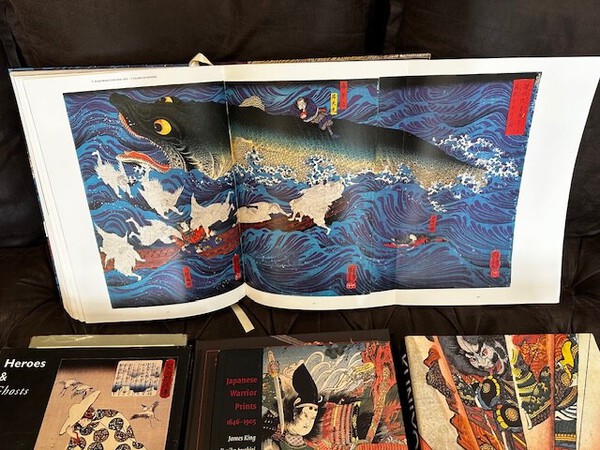

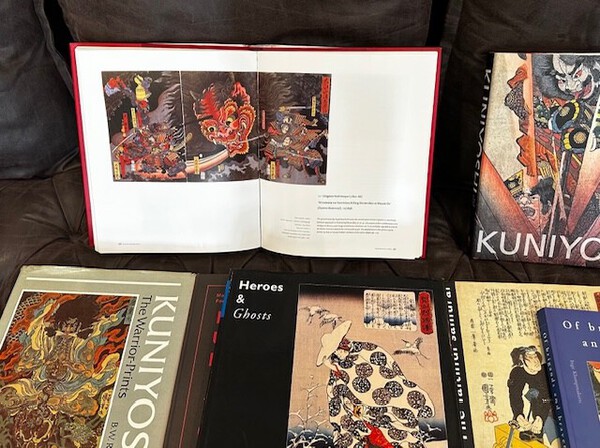




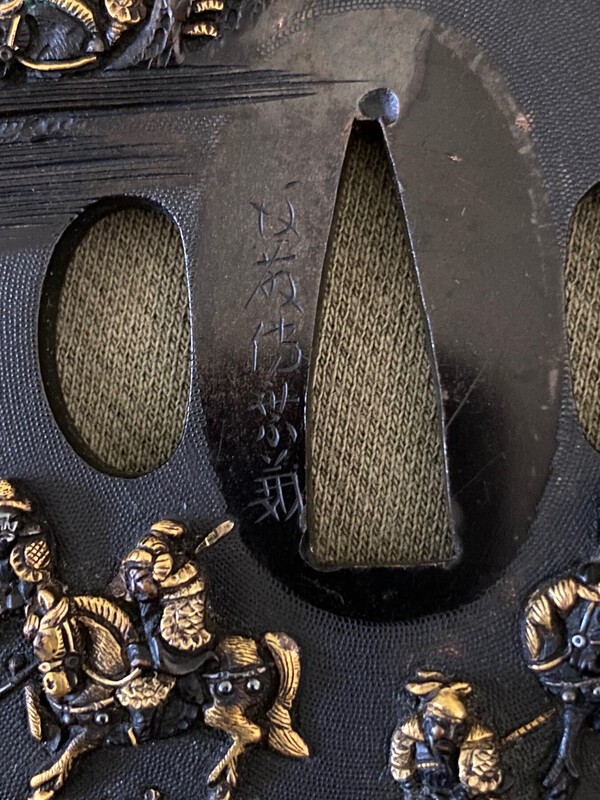










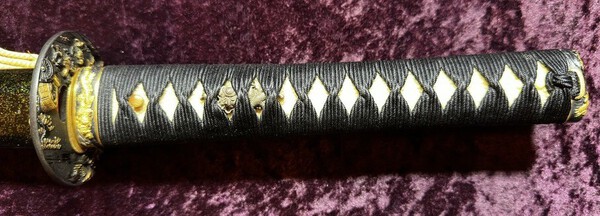


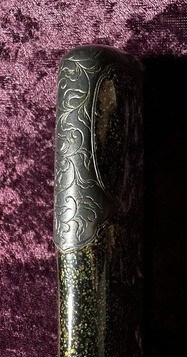
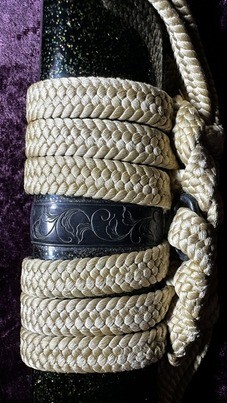
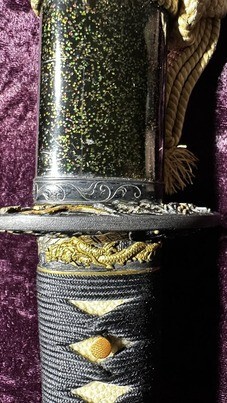

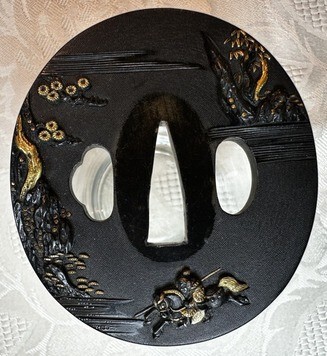
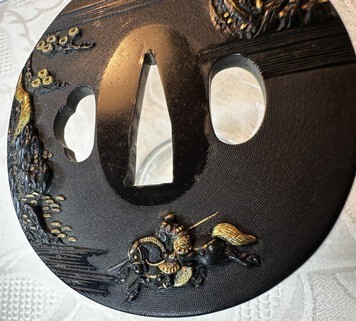



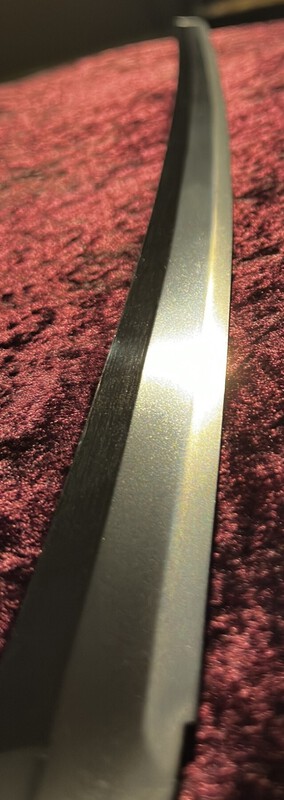


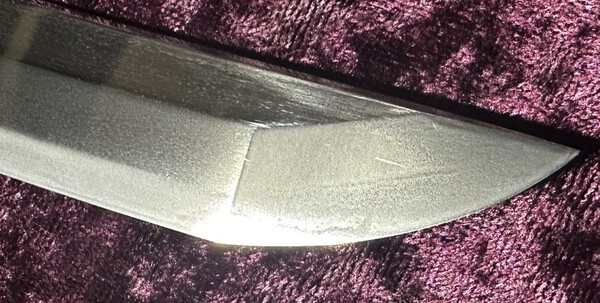

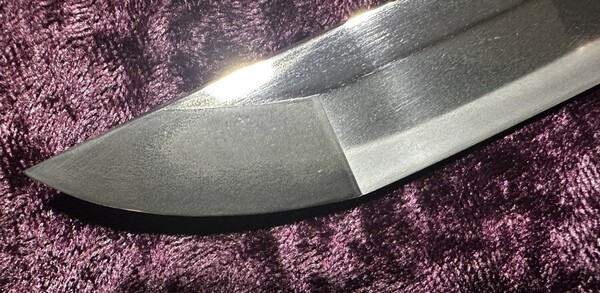











.thumb.jpg.fdad68c82b2fded068a755c96ef1d6cc.jpg)




